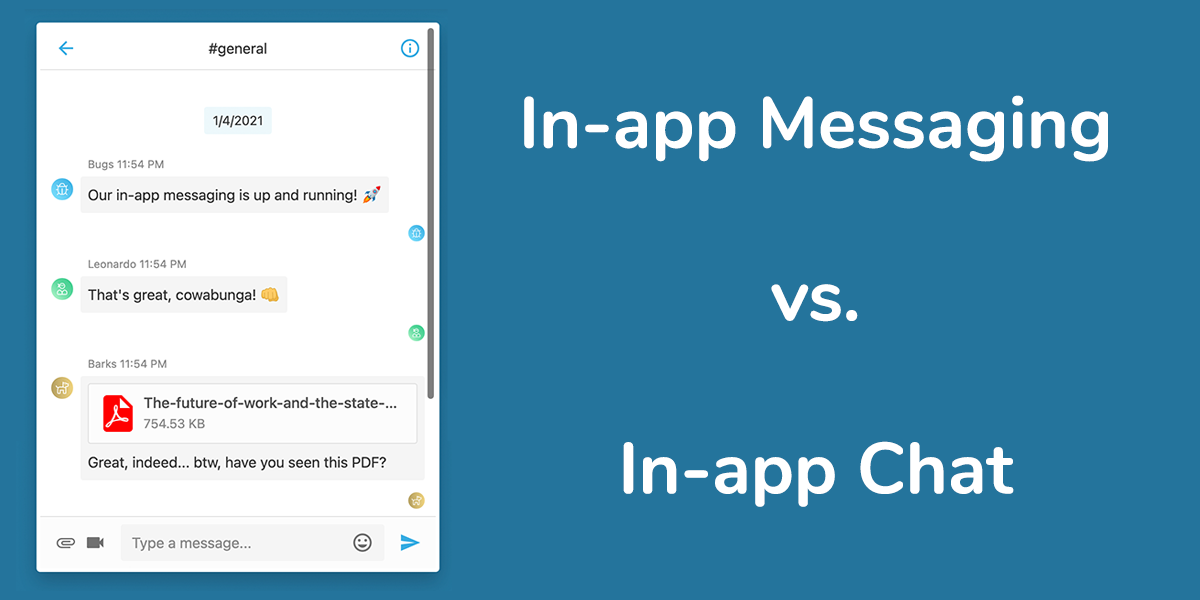 One of the great joys of working at a company like Weavy is that our team gets to have in-depth conversations with people involved in all aspects of app development. Keeping our ear to the ground like this helps us keep up with how to best service the development community, it also gives us the benefit of hearing about the latest trends.
One of the great joys of working at a company like Weavy is that our team gets to have in-depth conversations with people involved in all aspects of app development. Keeping our ear to the ground like this helps us keep up with how to best service the development community, it also gives us the benefit of hearing about the latest trends.
But one thing that has stuck out to many of our team is a lot of recent confusion around the terms “In-app Messaging” and “In-app Chat.” Some folks have been using them interchangeably, while others have been using one to describe the use case of the other.
To clear up the confusion, we’ve written a quick primer to explain the difference between In-app Messaging, an industry accepted term for one way communication to end users, and In-app Chat, which describes group and one to one communication.
What is In-app Messaging?
In the present age of SaaS apps, In-App Messaging has come to refer to targeting messages to end users from either administrators or app developers. These messages usually take the form of notifications or product tips and they have a number or purposes: onboarding new users, delivering important product updates, or advertising a new feature or service. By their nature these messages only move in one direction, from source to user, without giving the option of responding. These are all important parts of having a great user experience, but they also aren't Chat.
What is In-app Chat?
Broadly speaking, Chat refers to instantaneous text communication between two or more end users of an app. The most common implementation of In-app Chat by a wide margin is Direct Messages. Direct Messages, or DMs, is about as old as the web itself. From the earliest days of IRC and AIM to the present of Twitter and Instagram, DMs have been the standard against which all internet communication is measured.
Nowadays, with DM’s being a staple of both dedicated apps, business applications, and social media platforms, users have come to expect some things from their DM experience:
- Zero perceived latency
- Positive feedback such as send or read receipts
- Support for media rich messages (photo, video, gif)
- Robust compatibility with file formats and in-chat rendering
To paraphrase an old Apple ad campaign, sending and receiving DMs should just work. The second the end user can see behind the scenes the experience breaks down quickly. Delays in messages or poor file format support are non-negotiable in this day and age.
On the other side of the Chat equation is Group Chat. Group Chats have become an integral way for people to communicate and organize in our personal and professional lives. On the personal side, group chats are a staple for casual communication among families and friend groups. While on the professional side group chats are the easiest way for different teams within an organization to have direct or ad-hoc communication, to say nothing of having things like “off-topic” or “after hours” chats to help foster a good corporate culture.
No matter how it is implemented, most end users have some pretty reasonable expectations of their Group Chat experience. In addition to all the expectations established for DMs, Group Chat users expect:
- No perceived limits on number of users in a chat
- The ability to tag other users using the @ key
- Administrative privileges for all or some of the end users to add or remove users
Of course, the real power of In-app Chat features comes when you give your users the ability to collaborate contextually. While being able to communicate in groups or one to one with your colleagues reduces a high degree of friction, being able to discuss specific data points or tasks supercharges collaboration. Good apps add the ability to chat in app, great apps add the ability to chat contextually.
Why Chat should be a part of your app
At Weavy, we believe that Chat is a crucial part of adding rich, contextual collaboration to your app. For this reason, we’re now calling our direct and group messaging features Chat. With hybrid work becoming the norm, In-app Chat is no longer a “nice to have,” it’s become an expected part of the user experience.
Beyond meeting user expectations, the benefits of adding Chat to your app can’t be ignored. The most obvious benefit is increased engagement. The more your users are having their conversations in your app, the more engaged with it they are. This comes with the second-order effect of increasing user retention, which in turn means a lower churn rate if your app runs on a subscription model. It's been proven again and again that when app engagement goes up a little, app churn goes down significantly.
Similar terms, different outcomes
In-app Messaging and In-app Chat are far from being the same. Both are components of having a great user experience. In-app Messaging provides an easy way to communicate with your end-users and create a smooth experience, but In-app Chat provides a way for your users to communicate with each other, creating an experience that makes your app indispensable.
In terms of adding value to your app, adding Chat functionality using an API or SDK is a low effort, high yield solution, as it makes communication about the data in your app a seamless experience for your end-users. In the past year, Chat functionality has transformed from "nice to have" to an essential part of any productivity application.